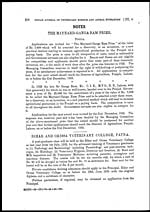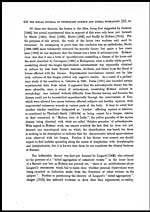Medicine - Veterinary > Veterinary colleges and laboratories > Indian journal of veterinary science and animal husbandry > Volume 3, 1933 > Original articles > Etiology of bursati
(275) Page 217
Download files
Individual page:
Thumbnail gallery: Grid view | List view

ORIGINAL ARTICLES
THE ETIOLOGY OF BURSATI
BY
CAPTAIN S. C. A. DATTA, B.Sc., M.R.C.V.S.,
Temporary Veterinary Research Officer, Imperial Institute of Veterinary Research,
Muktesar.
(Received for publication on 27th May 1933.)
(With Plates XIV—XIX.)
INTRODUCTION.
The history of the disease condition of equines in India, commonly known as
Bursati, dates back for more than 100 years when Kerr [1829] published what
appears to be the first article on the subject. In the intervening period numerous
papers have appeared with the object of elucidating important aspects of the disease,
such as the etiology, pathology and treatment, but it is noteworthy that workers
as yet are not agreed as to the precise nature of the causal agent or the mechanism
of infection. The present investigation was, therefore, commenced at the suggestion
of Mr. F. Ware, F.R.C.V.S., I.V.S., Director of this Institute. Army officers were
circularized for specimens of Bursati tissue, and Veterinary authorities in different
countries, where allied conditions exist, were also addressed, as a result of which
some interesting information was collected from Australia, the Argentine, Greece
and Egypt. It may be stated here that in an earlier article entitled " Histopatho-
logical Studies on 12 cases of Helminthic Granuloma of the Equine Skin", which
was read before the 20th Session of the Indian Science Congress, held in Patna in
January 1933, a preliminary note on the present investigation has already been
recorded.
With regard to the etiology of the condition, the views current at present may
be included in one or other of two well-defined hypotheses, viz. :—(1) that it is of
mycotic origin, being caused by some species of fungus which finds its way into the
horse's skin in a manner not yet understood; (2) that the disease is caused by
helminth parasites deposited in pre-existing sores by flies,
(217)
B
Set display mode to: Large image | Zoom image | Transcription
Images and transcriptions on this page, including medium image downloads, may be used under the Creative Commons Attribution 4.0 International Licence unless otherwise stated. ![]()
| Permanent URL | https://digital.nls.uk/75230299 |
|---|
| Description | Covers articles from 1933. |
|---|




